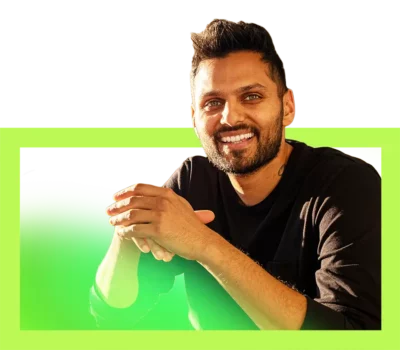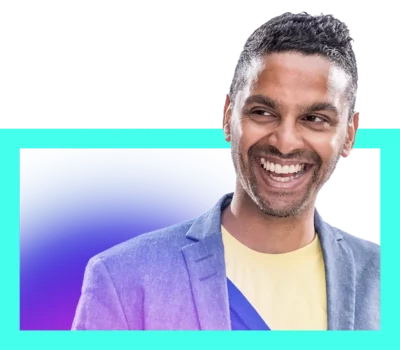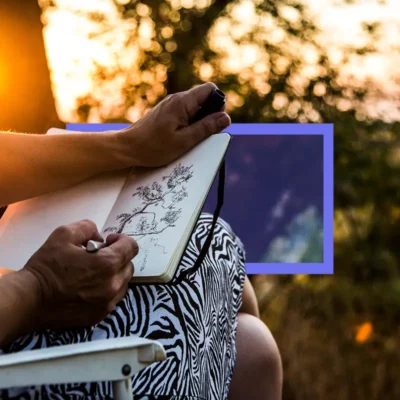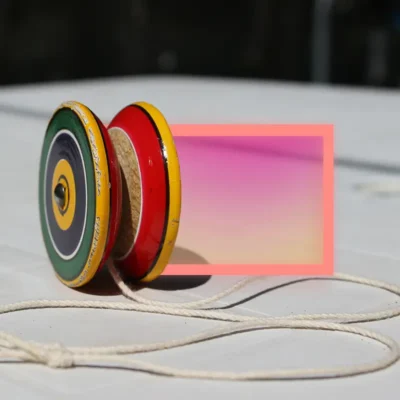Learn to see the layers in everyone
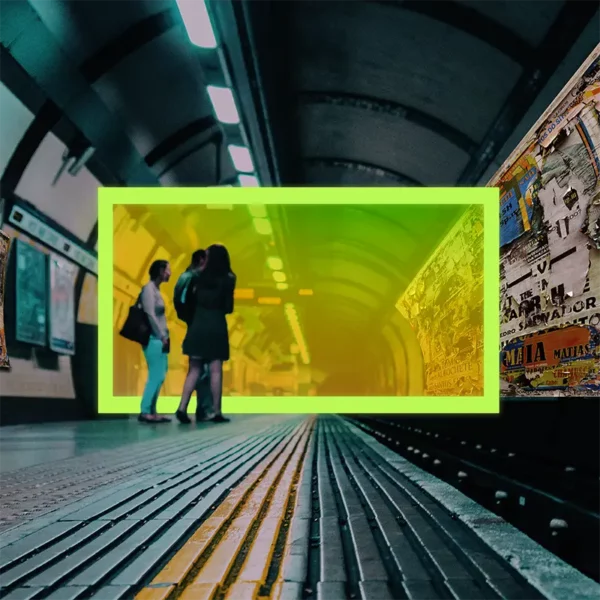

Table of Contents:
Transcript:
Learn to see the layers in everyone
JAY SHETTY: Layer after layer, I see ad after ad poking through. Pops of color. Fragments of letters. Within those layers is the history of that one single space. I think: What are my layers?
ROHAN GUNATILLAKE: Jay Shetty is admired for his work as a podcaster to help wisdom spread in today’s digital world. Known for his ability to see the complexity in people, Jay shares a Meditative Story today about suspending judgment on others until he is able to see beyond the surface of first impressions. It’s a story he is telling for the first time here. And if you follow Jay, his first book, Think Like a Monk, may be of great interest.
In this series, we blend immersive, first-person stories with mindfulness prompts to give you a deep sense of wellbeing at any time of the day. From WaitWhat and Thrive Global, this is Meditative Story. I’m Rohan, and I’ll be your guide.
The body relaxed. The body breathing. Your senses open. Your mind open. Meeting the world
SHETTY: “Why?” Mr. Buckridge, my high school art teacher, waits for an answer to his question. I am silent. Seconds feel like hours. He continues. “Why do I see more of this, and less of that?” I am frozen, staring at the piece of art that sits on the wooden desk in front of me. I want to respond. But what will satisfy him? And most importantly, what will release me from this awkward, uncomfortable moment? He waves his hand in frustration.
My art piece consists of six layers of transparent, Perspex plastic sheets, each overlapping the other. I carefully hand-pick articles, newspaper cuttings, images, and quotes that represent how I see myself. I stick one of these paper cuttings on Perspex and then rip it off. I run my finger along the jagged edge, which is left behind. I think it looks cool. I put on another layer of plastic. I place another item from my collection and rip it again. Again. And again. And again. It’s quick and fun and easy to make. It looks edgy. Pretty urban. Something that may be featured in one of the design magazines.
I love it. Mr. Buckridge doesn’t. He always wants me to dig deeper and question myself. “Why, why, WHY?”
I feel frustration rising in me everytime he asks that question. I want to give him a deep, profound answer, but my mind goes blank. The words spill out of my mouth: “I think it looks good?”
“Go back, restructure the piece. Be intentional about each choice you make, and tell me WHY?” Mr. Buckridge walks away shaking his head.
When critiquing my art, he never lets me get away with a random answer. He pushes me. And even though my art sometimes looks better than everyone else’s in the class, I still get the lower grade. He knows there is more in me.
As he moves on, done with me, I think about how one night, traveling in the Underground in London, I had come across a billboard. The image on it is ripped. Sneaking out behind the tear are parts of other ads. Old ones. Messages that existed in its place before someone came along and covered it up with this new pronouncement. Layer after layer, I see ad after ad poking through. Pops of color. Fragments of letters. Within those layers is the history of that one single space. I start to think: What are my layers?
Back in art class I begin to re-organize my piece.
What are my layers?
This time, I dig deeper. I question every decision I make when reworking the piece. Every time I place a layer, I ask the question “Okay, why am I doing this now?” Rather than, “How am I going to explain my choice later?” My confidence rises as I become more intentional about each decision. For the first time, I examine the multitude of layers that make up who I really am. I am comfortable sharing them because I now know why.
I return to Mr. Buckridge with the re-organized piece.
“Why can I see more than one layer?” he asks again when I’ve turned the piece in for a second time.
I trace my finger over the top layer. “At the top – the most superficial layer – is a picture of me. It’s all just blood and skin. This is the most superficial level. It’s the part of me you can see immediately before you, with no effort.”
I continue deconstructing my choices. “The layer just below my face is a lyric from an Eminem song.” It was Eminem who taught me how to journal, funnily enough.
I continue with my explanation. “When I was younger I was bullied for being overweight and being one of the only Indian kids at school. I was taunted in the hallways and made to feel like an outsider, a geek, a nerd. To cope, I would spend a lot of time writing these lyrics about how I felt. I’d fill these notebooks with my thoughts every single day as I listened to Eminem CDs. I was expressing myself, doing exactly what Eminem did all those years ago through his lyrics, journaling about his life with the rawest vulnerability one can bring to the table.”
Once I get going I don’t stop. “The next layer is the ‘I Have a Dream’ speech’ from Dr. Martin Luther King Jr., and peering out behind that are excerpts from my favorite books. Each piece is torn to reveal the quote that matters to me the most.”
Now, the undermost layer is filled with words from the Bhagavad Gita, a 5,000-year-old Indian text of literature and philosophy in the Hindu tradition. It encourages me to ask questions about the purpose of my life. It is the deepest layer of me. That layer is the core. It’s the part that I don’t fully understand at the time, so it hides and blends in, almost invisibly, into the background.
I hear myself saying to Mr. Buckridge, “Well, this layer here is the deepest level of me. It is harder to see and it takes more attention to notice it.” Together, we peer at the words from the Bhagavad Gita, buried under all the other layers, but in plain view if you are observing closely and with an intent to discover who I am.
I conclude by saying, “The whole piece represents peeling away the layers of myself, one by one, to understand the fuller picture of who I am.”
Mr. Buckridge pauses, smiles, and moves on. He is satisfied, and so am I.
He never stops asking me the question: “Why?”
GUNATILLAKE: Is there someone in your life that Jay’s teacher reminds you of? Bringing them to mind, how does remembering them make you feel? How are they here with you now, in body, in mind?
SHETTY: Redoing the piece makes me realize, I’ve been living unconsciously by the code that society hands us. This desire to just look good on the surface, to show that we have it all together. But there’s no satisfaction. In fact, there is no way to see ourselves in not having a “Why?” to answer to. Mr. Buckridge helps me discover that if I am able to connect with my own “Why?” then I inherit confidence and conviction in my own ideas. And that means that I do not have to search for external validation because I validate myself.
This way of searching beneath the surface opens up something powerful in me. It’s something I carry with me. Everyone I meet will, inevitably, have more going on than what they reveal in our first interactions.
In college, I have this desire to bring students together to have deep and meaningful conversations. There isn’t really a home for that sort of thing on campus, so I decide to create the space for it. I form this society called Think Out Loud. We meet in this small lecture room. We lay out the chairs in an oval. We start with 10 people but the group eventually grows to over 100 every single week. The room is long with dark, blue carpet. I light incense before we start. And containers of hot vegetarian food sit in the corner for us to enjoy after each session. Every week I create interactive exercises, games, and time for personal reflection.
There is this one girl who comes each week.
I often catch a glimpse of her out of the corner of my eye. As she approaches me, I can feel her negativity wash across the room. Whenever I ask her, “How’s everything going?” She invariably starts with what is going wrong in her life. “I had a fight with my mom… I am having an issue with a teacher… Me and my brother aren’t getting along.” Every week is a new complaint.
I think to myself, “Wow, how can she ALWAYS be so negative?!” There are people who have it so much worse than her; people who society has disadvantaged, yet exude hopefulness and self determination. I can’t help but look at her and think: “How can she be so ungrateful?”
With every encounter, I autofill her sentences, like Google, based on past searches. It’s natural. It’s easy. It’s where I just go, especially when I don’t have the full story. I create her story in my mind, filling in the gaps without any real basis to do so. With more time and patience, more of her truth begins to surface in this space I’ve created. We talk about her parents’ divorce. I find out she’s worried about her mother’s disability. I learn about the endless hours she spends taking care of her mother. I discover that her brother is an alcoholic and a drug addict and creates an abusive environment. Layer after layer starts to reveal itself.
As these layers begin to unveil I notice the moment when I start to really listen to her pain. I realize that I didn’t really understand her at all. I am limited by my own experiences and the challenges that I have overcome. I expect her to overcome things in the same way.
It’s so easy to witness someone in a single moment, and it’s efficient to paint the picture with a surface-level story. Snap judgments are made knowing the 1% of the information about their life. I fall into this trap by default. It is so easy to get angry at the person on the road who pulls in front of me, or the doorman who refuses to smile, or the waitress who refuses to be kind, or the countless people I brush up against in the swift, hectic pace of my life.
When you’re hearing someone’s surface-level story, you just can’t see that there’s so many other factors at play. We all have so many layers to our story at any given moment, and the layers are always changing.
I can’t expect this girl who attends our weekly Think Out Loud meetings to have a different perspective or “just be grateful.” I can’t ask her to feel a particular way because my experiences might allow me to feel a particular way in that situation. I can’t just throw advice at someone and expect it to stick. That’s humbling to learn: how to be with people without trying to change them. By listening intentionally and being more aware of my snap judgements in my exchanges with this girl, I start to change.
So every week, in that lecture hall I listen more deeply. I really listen.
GUNATILLAKE: Listen with Jay, in the college hall where he is. Here, in the space where you are right now. Can you listen with the same energy, with intention, aware of the quick-to-judge mind?
SHETTY: I know I am not giving her any lightbulb moments, I am not sure how much her life changes at all because of me; but I am growing in ways I couldn’t imagine, because of her.
If I can stop assuming we are all going through the same stuff – stop stripping the unique richness and layers that come from being human – then I start to understand them better, and together I understand myself better. More clearly. More compassionately.
When I listen to other people, with no hopes of giving good advice, I figure out how to listen to myself. I start giving myself more time. And with time comes patience and compassion.
A simple photograph of myself. That was the top of the art piece I created in Mr. Buckridge’s class. Nothing special. All the things you’d expect to see on the surface.
That picture is just the shallowest snapshot of my life. But it invites you to make a complete judgment about me if you allow it to do so. If I stay on the surface, if I assign people I meet to a box they were never meant to fit inside of, then I never actually see them shine in their greatness.
I can’t force anyone to show me their layers, or to reveal the fuller picture before they wish to. That’s just not my purpose. That’s not my “Why?” But I can show up, pull up a chair, and listen. If I lean in close enough, and quiet my own thoughts, I can see layer after layer emerge, each telling me something I didn’t see before. The layers are always there, in every one of us, waiting to be coaxed out into the open, waiting to be understood.
Rohan’s closing meditation
GUNATILLAKE: Layers. Layers and revelation. That is the theme that stayed with me the most from Jay’s story. So for the meditation we’ll do together, I thought it might be fun if we mirror Jay’s schoolboy creativity, and go on our own journey, six layers down.
And starting by meeting the world, senses open. Eyes, ears, whatever capacity you have in this moment, letting it be alive and bright. Awareness relaxed, no need to single anything out, and just soaking in the world outside. Letting your sense of the space around you, the world around you be known, be vibrant. This is the first layer.
Moving inwards now. One layer down to the boundary where the world meets the body. Knowing the temperature of the world on your skin. Any flutters, any vibration, any breeze, any stillness. Eyes open or eyes closed, whatever is safe and feels right for you. Resting your awareness with this boundary, the sensations on the skin.
Dropping down again, inwards again, from the skin to the muscles. Scanning the muscles of the body and noticing any major areas of tension that are here. Belly, shoulders, hands, jaw, eyes. And letting that awareness be a trigger for letting go. The release of tension where possible following the momentum of our meditation down and down.
Going deeper still, another layer down to the breath, hosted and alive within the body. Become sensitive to how the breath is manifesting for you in this moment. Feel its aliveness, this low key hero, supporting your energy and fluidity whatever might be happening around it. And if you have access to some calm in this moment, letting the awareness hang out in the quietness of the breath. Letting its subtlety lead you further inwards.
Now, beyond the breath and to the heart, this center of movement and of emotion. If you can actually feel the beating of the heart on the wider body then feel that, enjoy that. If the subtlety isn’t quite here at the moment then that’s ok. Let your awareness collect and rest in the heart area and enjoy that.
And for our sixth and final layer today, turn your awareness on your awareness itself. That instruction might feel entirely natural, or what I’ve said might feel utterly nonsensical. Either way it’s no matter. Entirely relaxed, let awareness be intimate with itself. Sensitivity and revelation all the way down.
Thank you.
